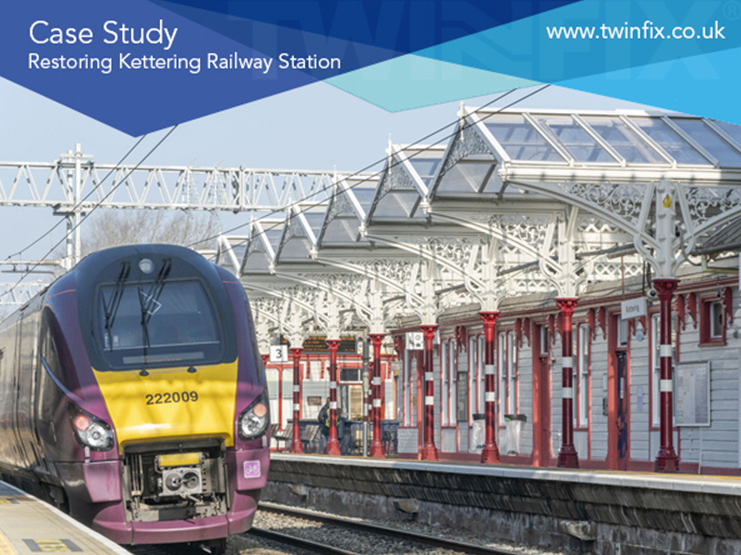Twinfix have been working their magic to help Network Rail restore Kettering Railway Station to its former glory. They have been helped in this project by the Railway Heritage Trust (RHT).
The Railway Heritage Trust was created in 1985 by British Rail on the advice of railway heritage campaigners following the destruction of Derby Midland Station. The RHT is an independent company which assists the operational railway in its preservation and upkeep of listed buildings and structures. Network Rail and National Highways (Historic Railways Estate) sponsor the work of the RHT which currently holds an annual budget for restoration work, ensuring that high quality and the best materials are used to restore and preserve assets.
Kettering station was opened in May 1857 by the Midland Railway, on a line linking the Midland to the Great Northern Railway at Hitchin. The Midland later gained its own London terminus at St Pancras Station. In 1857 the leather trade was in recession with over half of Kettering’s population on poor relief. The railway enabled the town to sell its products over a much wider area and restored the town’s prosperity. Originally the station had a single platform but in 1879 the station was quadrupled, and three new platforms were built. The Midland Railway commissioned waiting rooms, cast-iron columns, spandrels, and canopies for the new platforms to match the original 1857 design by Charles Henry Driver. In the 1970s, the glass canopies became a maintenance headache for British Rail, who proposed removing the glazing along with the cast-iron column heads and replacing it with sheeting. Thankfully, Kettering Civic Society intervened and saved the canopies and columns. 50 years later these important architectural elements needed some refurbishment but faced another threat. The Midland Mainline electrification programme meant that structural changes would be needed to the canopy structures to allow the overhead line electrical equipment to be installed above the tracks. Once again, the canopies were under threat but this time it was Twinfix which came to the rescue.
Twinfix, the Warrington based pioneers of polycarbonate were the specified experts in the Network Rail business plan for the station refurbishment. Having already helped bring new life and importantly light into old stations as part of refurbishment work, Network Rail stipulated using Twinfix’s polycarbonate roofing panels and their mounting system to keep the overall aesthetics of the station but add a much-needed resilience to the canopies.
Twinfix recommended their Multi-Link-Panel glazing with 6mm solid clear polycarbonate to help the restoration project. The Multi-Link-Panel is an innovative, modular system that is incredibly quick to install and outperforms more traditional systems in terms of cost, performance, and appearance. Multi-Link-Panel canopies consist of pre-assembled modular glazing panels, manufactured to size for each individual project. Each panel comprises aluminium structural bars that are glazed with lightweight, yet tough, solid polycarbonate. The aluminium can be powder coated to a range of colours for a rust and maintenance-free life. As panels are pre-assembled in a controlled factory environment possible contamination and errors in installation caused by on-site cutting of the glazing sheet are avoided. These properties can result in saving two thirds of the time taken to install traditional split bar glazing systems. This can save on labour costs and drastically reduce any necessary premises shutdown time required while work is carried out overhead. The team at Everlast roofing who installed the Twinfix Multi-Link-Panel were a great partner in this installation process and this partnership resulted in a great finished roof.
Handling during installation is easier and safer than with traditional glass systems as panels are constructed from materials that are both strong and light in weight. The reduction in weight compared with glass systems has the added benefit of lowering the overall weight of the roof construction, decreasing the stresses on the existing fabric of a building, especially important where a roof refurbishment is being undertaken. It is this weight reduction that removed the need for reinforcement of the original columns and resulted in the restoration remaining faithful to the original design.
As Twinfix manufacture the multi-link panel system they are in an ideal position to be able to help with designing out potential problems. Each roofing system is unique and bespoke, so Twinfix took advantage of their deep understanding of their product and the legislation covering such projects and added access hatches to the canopies which allow access above the glazing for maintenance, finally curing that 50-year-old headache.
Vicky Evans, Director at Twinfix said; “The result of the restoration is truly breath-taking. Kettering Station is now awash with natural light and the platforms are a light airy place to wait for a train and shelter from the elements.”
Tim Hedley-Jones, Director of the Railway Heritage Trust, says of the project: “It’s a great example where the use of modern materials helps to protect and sustain a truly beautiful historic station. Our grants have helped Network Rail to preserve Kettering Station using Twinfix technology, to continue to make it fit for purpose for today’s rail passengers.”
So, if Charles Henry Driver were able to see the station today, he would instantly feel a sense of familiarity and be proud of the restoration work on this piece of railway treasure.
CREDIT: Photographs taken by Paul Childs, Spheroview









